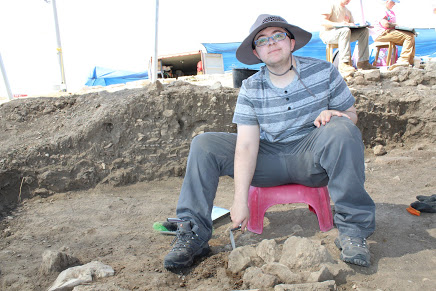by Quentin Stickley. Archaeology is my passion, but as someone who lives with chronic pain, I have always been concerned that working in the field might prove impossible for me. My time at Tel Akko has demonstrated to me that although much of the excavation process involves physical labor, disabled people are not necessarily precluded from participating, either in the field or in the laboratory. Excavation is a team process, and there are many different tasks to be done, all of which are necessary for the new data to reach a state in which it can be easily accessed and manipulated for research purposes.
In recent decades, the amount of lab work done by archaeologists has increased, with the presence of archaeobotanists and zooarchaeologists on excavation teams becoming standard. Archaeobotanists study ancient plant remains, such as seeds, which have been preserved through charring by fire, and zooarchaeologists study animal bones to learn about the humans who raised or hunted those animals. Tiny objects and organic remains are filtered from soil and brought to the lab, where they must be manually checked to sort useful materials from small pieces of gravel and modern plants. Items that can be recovered this way include bones, seeds, shells, beads, and small metal pieces and potsherds. After they have been sorted and weighed, each subset of materials goes to the respective specialist who studies them for identification and analysis. Archaeologists keep careful track of the location from which each sample was recovered so that they can draw conclusions from the distribution of materials. A sample which yielded a comparatively large amount of iron slag, for example, may have come from an area that was used for refining and working metals, or a sample with a lot of chaff may have come from a grain processing area. In my experience, people either love sorting these samples or they hate it. Personally, I find it almost meditative. It requires focus, but the occasional interesting find, such as a fish tooth or an ancient bead, keeps it from becoming monotonous. There are other jobs to do off the tel as well – potsherds and bones need to be washed and marked or sorted, for example.
Even excavation may be doable with appropriate modifications and assistance. Because most of my pain is localized in my feet and knees, squatting or kneeling is very difficult for me, but I have little trouble in the field as long as I have a stool to sit on (it’s not safe to sit on the ground at our site, because of the presence of burrowing scorpions who may not appreciate running into someone’s posterior). I would encourage disabled people who are interested in doing archaeology to talk with the excavation staff and supervisors to work out accommodations or alternative tasks, and not to be shy about asking for help or taking a break if you need one. I have found that the staff here at Tel Akko are immensely understanding and helpful in this regard.


1 Comment